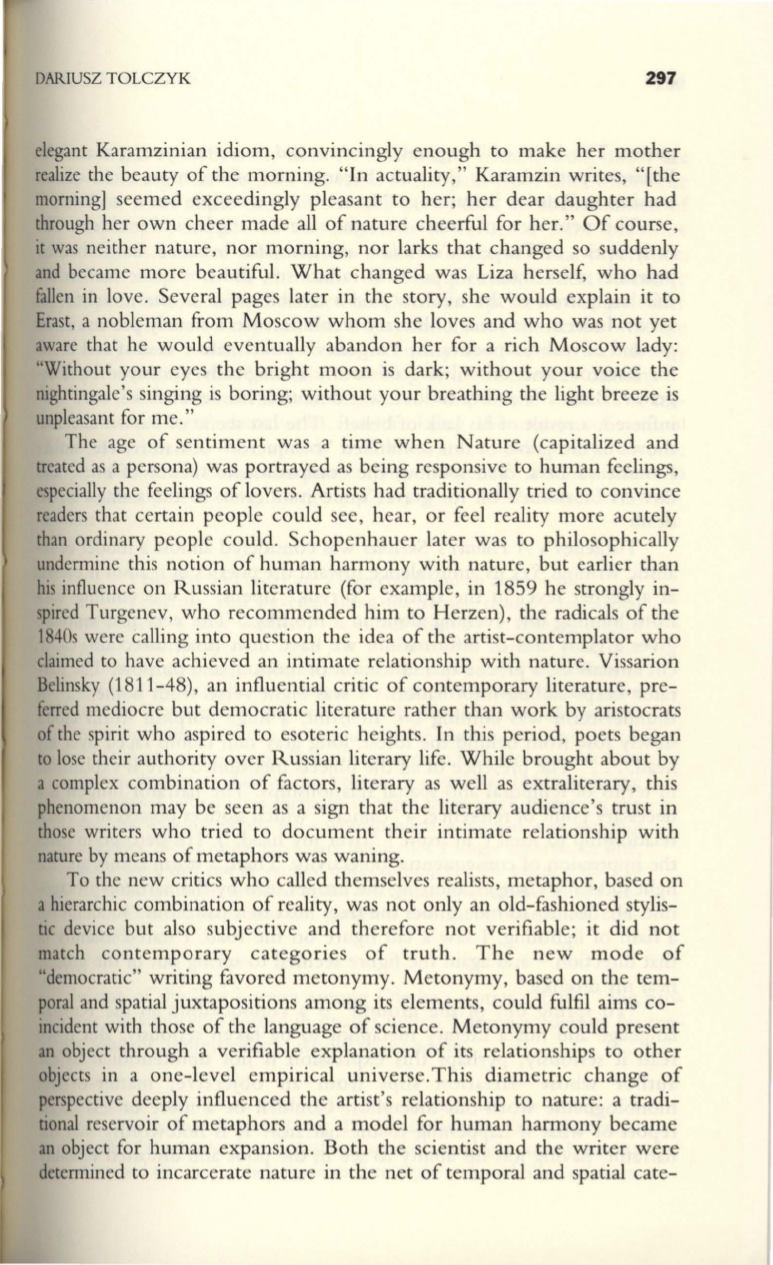
DARIUSZ TOLCZYK
297
elegant Karamzinian idiom, convincingly enough to make her mother
realize the beauty of the morning. "In actuality," Karamzin writes, "[the
morning] seemed exceedingly pleasant to her; her dear daughter had
through her own cheer made all of nature cheerful for her." Of course,
it was neither nature, nor morning, nor larks that changed so suddenly
and became more beautiful. What changed was Liza herself, who had
fallen in love. Several pages later in the story, she would explain it to
Erast, a nobleman from Moscow whom she loves and who was not yet
aware that he would eventually abandon her for a rich Moscow lady:
"Without your eyes the bright moon is dark; without your voice the
nightingale's singing is boring; without your breathing the light breeze is
unpleasant for me."
The age of sentiment was a time when Nature (capitalized and
treated as a persona) was portrayed as being responsive to human feelings,
especially the feelings of lovers. Artists had traditionally tried to convince
readers that certain people could see, hear, or feel reality more acutely
than ordinary people could. Schopenhauer later was to philosophically
undermine this notion of human harmony with nature, but earlier than
his influence on Russian literature (for example, in 1859 he strongly in–
spired Turgenev, who recommended him to Herzen), the radicals of the
1840s were calling into question the idea of the artist-contemplator who
claimed to have achieved an intimate relationship with nature. Vissarion
Belinsky (1811-48), an influential critic of contemporary literature, pre–
ferred mediocre but democratic literature rather than work by aristocrats
of the spirit who aspired to esoteric heights. In this period, poets began
to lose their authority over Russian literary life. While brought about by
a complex combination of factors, literary as well as extraliterary, this
phenomenon may be seen as a sign that the literary audience's trust in
those writers who tried to document their intimate relationship with
nature by means of metaphors was waning.
To the new critics who called themselves realists, metaphor, based on
a hierarchic combination of reality, was not only an old-fashioned stylis–
tic device but also subjective and therefore not verifiable; it did not
match contemporary categories of truth. The new mode of
"democratic" writing favored metonymy. Metonymy, based on the tem–
poral
and spatial juxtapositions among its elements, could fulfil aims co–
incident with those of the language of science. Metonymy could present
an object through a verifiable explanation of its relationships to other
objects in a one-level empirical universe. This diametric change of
perspective deeply influenced the artist's relationship to nature: a tradi–
tional reservoir of metaphors and a model for human harmony became
an object for human expansion. Both the scientist and the writer were
determined to incarcerate nature in the net of temporal and spatial cate-


